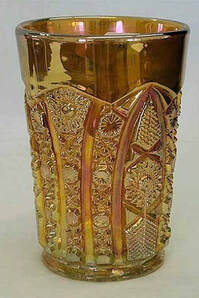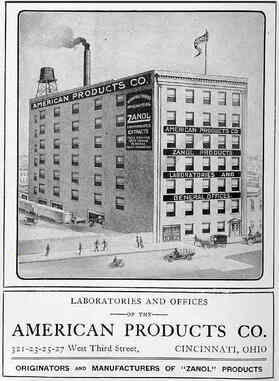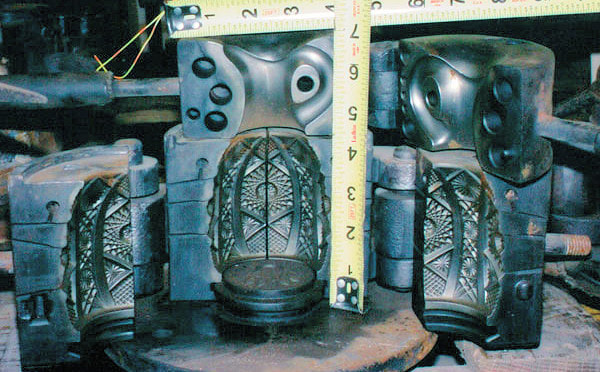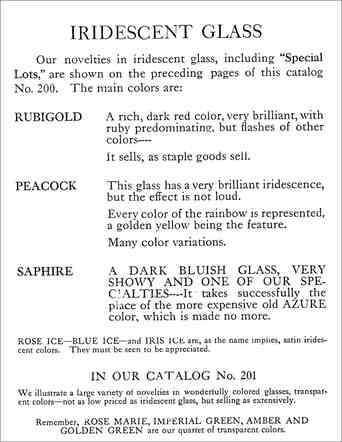Imperial's Octagon - The Story Behind The Glass.
Copyright G & S Thistlewood
|
Let's start at the beginning in 1913 – A Year to Remember
Did you know that Imperial gave this pattern the delightful Original Maker’s Name (OMN), “The Bellaire”? In February 1913, Imperial introduced their new No. 505 pattern. That month, the “Pottery, Glass & Brass Salesman” ran an ad for Imperial’s “Nucut” lines, stating that their “great No. 505 Bellaire open stock pattern, in light crystal, is illustrated in a large variety of pieces for the first time”. This new design wasn’t just a number – they also named it “The Bellaire” in honour of the city where Imperial’s glass works was located: Bellaire, on the banks of the great Ohio River. Extract from Imperial’s February 1913 Supplement to the General Catalog.
Courtesy Jon D Bartell. |
Imperial purple Octagon decanter set.
Courtesy Seeck Auctions |
|
Just a few weeks after the launch, in March 1913, several winter storm systems merged to devastating effect, bringing disastrous and destructive floods. By the 24th March, all rail, telegraph and telephone systems in Indiana, Ohio and Illinois were out of action. The Great Flood of 1913 would take hundreds of lives and devastate many more. More than a quarter of a million people were left homeless. The Imperial Glass Co., factory was a casualty of the floods. An ad from June 1913, selling the flood-damaged stock, reported that 28,000 barrels of glassware “were submerged in the Imperial Glass Co.’s factory”… “The glassware packed in the barrels was uninjured but the packing was ruined”. The goods, described as “Nucut Crystal Glassware” were sold off at half price, in what was a very challenging start for Imperial’s new “Bellaire” line. |
Extract from June 1913, “Brooklyn Daily Eagle” showing
the Imperial factory surrounded by floodwater. |
The "Bellaire" - pattern No. 505.
Thanks to and courtesy of Jon D Bartwell, shown below are two pages taken from the Imperial Catalog 100A (c. 1913).
Click on either image to see it in a larger size.
Thanks to and courtesy of Jon D Bartwell, shown below are two pages taken from the Imperial Catalog 100A (c. 1913).
Click on either image to see it in a larger size.
Imperial offered The Bellaire, pattern no. 505, as a new pattern in 1913; they described it as being much lighter in weight than their previous “heavy imitation cut glass” items such as Fashion, Diamond Lace and Imperial Hobstar.
Classic Carnival Production
When The Bellaire was launched in 1913, it was only being offered in clear crystal glass. Despite the fact that iridescent glass (Carnival) featured quite heavily in Imperial’s 1913 and 1915 catalogues (and their associated Supplements), Bellaire (Octagon) was not to be seen in them. In fact, the very first trade ad we have seen showing iridescent production of Octagon was not until it appeared in Butler Brothers, February 1920 wholesale catalogue, as shown on the left below. The ad featured three “Iridescent Berry Bowls” from Imperial; Octagon, Double Dutch and Imperial Open (or Beauty) Rose.
Classic Carnival Production
When The Bellaire was launched in 1913, it was only being offered in clear crystal glass. Despite the fact that iridescent glass (Carnival) featured quite heavily in Imperial’s 1913 and 1915 catalogues (and their associated Supplements), Bellaire (Octagon) was not to be seen in them. In fact, the very first trade ad we have seen showing iridescent production of Octagon was not until it appeared in Butler Brothers, February 1920 wholesale catalogue, as shown on the left below. The ad featured three “Iridescent Berry Bowls” from Imperial; Octagon, Double Dutch and Imperial Open (or Beauty) Rose.
Left: extract from Butler Brothers, February 1920 catalogue. showing Octagon, Double Dutch and Imperial Open (or Beauty) Rose.
Although described as "berry" bowls, they were full sized 8½ to 9 inch bowls. Octagon was made in a smaller sized berry bowl (it is shown in their Catalog No. 200, below). A full berry set consisting of the large bowl and six smaller ones is shown above on the right, courtesy of Burns Auctions.
Although described as "berry" bowls, they were full sized 8½ to 9 inch bowls. Octagon was made in a smaller sized berry bowl (it is shown in their Catalog No. 200, below). A full berry set consisting of the large bowl and six smaller ones is shown above on the right, courtesy of Burns Auctions.
By 1925, we see a very full line of Octagon shapes in Imperial’s Catalog No. 200 – all offered in iridescent glass. However, the pattern is now no longer called The Bellaire, but it is simply referred to as 505 (the "M" in the catalogue was product code for "Rubigold", that is marigold Carnival). The No. 505 table set, berry set and water set were all in this catalogue in 1925, the pitcher being the large size.
There is an interesting difference between the tumblers shown in the 1913 Catalog 100A, and the 1925 Catalog 200. In 1913, the tumblers did not have a marie / collar base - the pattern went all the way down to the bottom of the tumbler. They were made by the "stuck up" method; the tumbler was stuck onto a metal pontil rod with a dab of molten glass. When the pontil was removed it left a rough base rim which was had to be ground smooth.
|
The later and more efficient method of production was the "snapped up" process using a “snap” tool which fitted around the marie / collar base of the item - no pontil and therefore no grinding was required. The collar base tumblers are sometimes referred to as Octagon Variant. Above: an Octagon tumbler made by the "stuck-up" method, and below is one with a collar base, made using the
snap" tool. Both courtesy of Seeck Auctions. |
Above: extract from Imperial Catalog 200, 1925.
|
|
An Octagon water set in purple, with the large size pitcher - note
the four large hobstars in the central panel of the pitcher. The tumblers all have a collar base. Courtesy Seeck Auctions. |
This is the smaller Octagon pitcher, in marigold - the pitcher has only three large hobstars in the central panel. The tumblers are the "stuck up" version, ground flat underneath. Courtesy Seeck Auctions.
|
|
It’s interesting to see that the 8” No. 505 Octagon vase was described as a “bouquet” in Imperial’s Catalog 100A in 1913, shown on the right. In the later 1925 catalog it was shown as being offered in “three brilliant iridescent colors, rubigold-peacock-sapphire”. The vase shown on the far right is rubigold – marigold – and is shown courtesy Seeck Auctions. Iridescent Novelties were listed on 50 pages of the entire 149 page Catalog 200, indicating a very large Carnival output from Imperial at this point. And it wasn’t just marigold: the catalogue stated that iridescent glass was available “in several brilliant colors”. There is more information about Imperial's Carnival Glass colours in the section headed "Colour Side Note", at the end of this article. Easy Selling Goods and Premiums We have written extensively about the marketing and promotional techniques that were used originally to sell Carnival Glass. We have a unique set of feature articles that provide a fascinating insight into this whole subject - it will probably not surprise you that many of the sales-enhancing activities that we see all around us today, were also used way back in the early 1900s when Carnival Glass was being made. Here is the Homepage which provides links to all our articles on sales and marketing: Sell it to me! |
8” No. 505 Octagon vase. Seeck Auctions.
|
“A thing of beauty” indeed.
This set of six, large Octagon goblets (below, left) was offered for $1.98 in the 1925 Perry G. Mason Co. “Book of Easy Selling Goods and Premiums”. Imperial (and Fenton) Carnival appeared in this 1925 catalogue business that operated out of Cincinnati. They used agents all around the country to take mail order catalogues to customers, and an essential part of their approach was to include a selection of items offered as "free" gifts, incentives, and "premiums".
Thanks to Rich Shaw, we can show you the two pages below, of a Zanol “Glassware Advertising Circular”.
The pattern was referred to as “Clarendon”, and the items were offered free, when the customer purchased various dollar amounts of Zanol products, ranging from food to perfumes. The buyer was urged to “add an air of elegance to your table” with “the most exquisite pattern you have ever seen”. Click on either image to see it in a larger size. |
Above: the 1923 Zanol Advertising Circular, featuring Imperial’s Bellaire / Octagon line. The images are thanks to and courtesy of Rich Shaw.
|
When Imperial closed in 1984, Fenton bought many of their moulds, including some of the No. 505 moulds. Here are two of them (courtesy of the Fenton Family and Fenton Art Glass Company) - on the left is the cruet (no stopper), and on the right a bowl shaped mould. Amazingly, the bowl shaped mould is marked on the rim " 505" and "9" NAPPY".
|
Now to the question - how did The "Bellaire” / Imperial No. 505 / "Clarendon" pattern become Octagon?
To answer that, we need to push the clock forward to 1961, when Marion Hartung named this pattern “Octagon” in her Second Book of Carnival Glass. Although she had named many of the familiar Carnival patterns with apt and delightful names, arguably “Octagon” wasn’t her best effort. She explained that the pattern “consists of alternate panels composed of two sizes of flat-topped, lined octagons with file between, and panels carrying an intricate hobstar.” The difficulty is that those “flat-topped, lined octagons” can be very challenging to spot, whereas the eye is almost immediately taken by the larger six-sided (hexagon) framed hobstars. Around the same time, Rose Presznick named this pattern “Princess Lace” (Imperial Lace), but Hartung’s “Octagon” was the name that stuck and became commonly adopted by collectors for the Classic old Carnival production.
Contemporary Production
In Part Two of the Octagon story, we look at the revival of the Octagon pattern by Imperial, when - from the 1960s - they reissued it in Contemporary Carnival. We also look at the "imposters"- patterns that closely resemble Octagon but were made by other glassmakers.
To answer that, we need to push the clock forward to 1961, when Marion Hartung named this pattern “Octagon” in her Second Book of Carnival Glass. Although she had named many of the familiar Carnival patterns with apt and delightful names, arguably “Octagon” wasn’t her best effort. She explained that the pattern “consists of alternate panels composed of two sizes of flat-topped, lined octagons with file between, and panels carrying an intricate hobstar.” The difficulty is that those “flat-topped, lined octagons” can be very challenging to spot, whereas the eye is almost immediately taken by the larger six-sided (hexagon) framed hobstars. Around the same time, Rose Presznick named this pattern “Princess Lace” (Imperial Lace), but Hartung’s “Octagon” was the name that stuck and became commonly adopted by collectors for the Classic old Carnival production.
Contemporary Production
In Part Two of the Octagon story, we look at the revival of the Octagon pattern by Imperial, when - from the 1960s - they reissued it in Contemporary Carnival. We also look at the "imposters"- patterns that closely resemble Octagon but were made by other glassmakers.
|
Colour Side Note: the three main colours were Rubigold, Peacock and Saphire (sic) – which would be what we call marigold, clambroth and amethyst/purple. It’s interesting to note that Peacock is described as “every color of the rainbow is represented, a golden yellow being the feature” .. while elsewhere in the same catalog they describe Peacock as having “a golden pinkish effect” and also refer to it as “dainty”. This further emphasises that Peacock is certainly what we call clambroth, with its quixotic nature, with pinks and golds predominating. The three ice colours noted lower down were most likely, primarily for the stretch glass iridescent lines. The 1922 “Crockery and Glass Journal” reported that the “ ‘Peacock’ line, was a new and exceedingly rich, iridescent effect” which suggests that Imperial’s clambroth iridescence – the “Peacock” colour – was introduced in 1922. It is important not to confuse this clambroth iridescence with the later, Contemporary smoke iridescence that Imperial also called “Peacock”. The early 1920s Imperial “Peacock” is a light iridescence, with much gold and pink showing. The 1960s Contemporary Imperial “Peacock” iridescence is a dark, smoky effect on clear glass, sometimes showing brownish or grey, but often with a vibrant purple hue. Read Part Two of the Octagon Story: Contemporary production and "look-alike" patterns. |






















